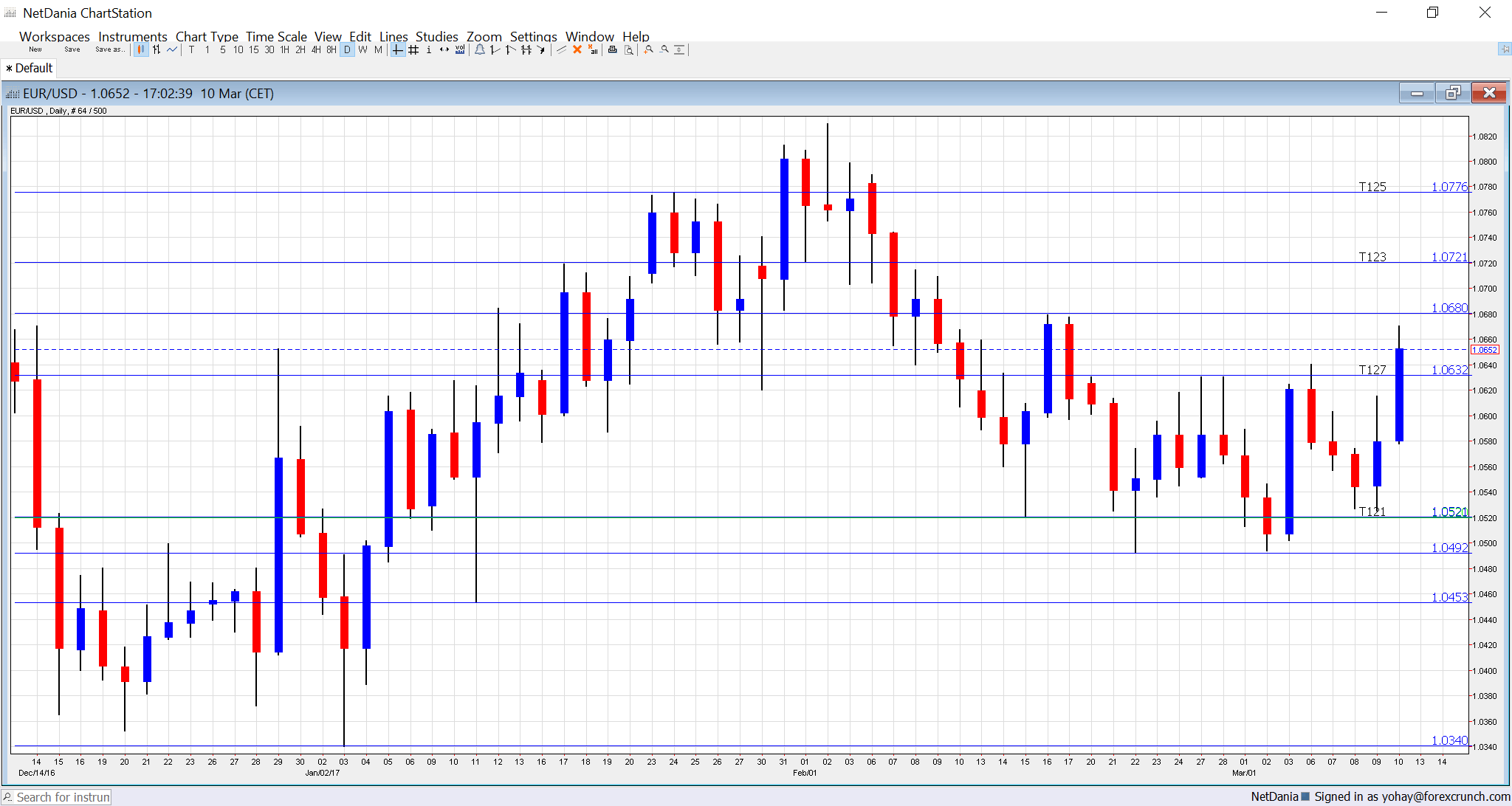EUR/USD managed to edge up as the ECB expressed some cautious optimism. Are more gains on the cards? Another appearance by Draghi, elections in the Netherlands as well as inflation and trade figures stand out in the upcoming week. Here is an outlook for the highlights of this week and an updated technical analysis for EUR/USD.
The European Central Bank removed a phrase regarding using “all instruments” to raise inflation and Draghi clarified that the Bank no longer wants to convey a sense of urgency. This slight hawkish tilt eventually tilted the euro higher. A further report suggesting that the ECB may opt to raise rates before the QE scheme ends provided a further lift to the euro. In the US, a robust jobs report cemented the rate hike coming next week. Which central bank will have the upper hand in moving EUR/USD?
[do action=”autoupdate” tag=”EURUSDUpdate”/]EUR/USD daily chart with support and resistance lines on it. Click to enlarge:
- Mario Draghi talks: Monday, 13:30. The President of the ECB has another opportunity to move the euro. He will speak at a conference in Frankfurt. Draghi could try to push the euro lower, countering the positive impact on the euro seen in the rate decision.
- German CPI (final): Tuesday, 7:00. The flash read for German inflation showed a rise of 0.6% in prices in February. A confirmation of the initial read is expected. Revisions are not common.
- German ZEW Economic Sentiment: Tuesday, 10:00. The ZEW institution published its business survey results early in the month. In the past three months, the figure fell short of expectations, It dropped to 10.4 points in February, though still in positive territory, reflecting optimism. An advance to 13.2 is on the cards. The all-European figure stood at 17.1 points last time and is expected to hit 19.3 now.
- Industrial output: Tuesday, 10:00. Back in December 2016, industrial output fell by 1.6%, more than had been expected. With a bounce in German industrial output of 2.8% in January, also the euro-area number is projected to be positive now: +1.2%.
- Elections in the Netherlands: Wednesday, exit polls due in the evening, full real results later on. The Netherlands holds parliamentary elections that will most likely result in a fractured parliament with a dozen parties and long coalition negotiations. The biggest parties that will likely emerge are incumbent PM Mark Rutte’s party and the extreme right Freedom Party led by Geert Wilders. Wilders will most likely stay out of any coalition, as other parties ruled him out, but the outcome does matter. If he emerges as the leader of the biggest party, this could underpin another extreme-right candidate in France: Marine Le Pen. If Rutte’s party comes on top, it could be a sign that populism is on the retreat.
- French CPI (final): Wednesday, 7:45. According to the flash read for February, prices increased by 0.1% in the eurozone’s second-largest economy. The figure will probably be confirmed.
- Employment Change: Wednesday, 10:00. This quarterly measure lags behind more frequent data but provides a wide picture. In Q3, overall employment increased by 0.2%, slower than in previous quarters. The same pace of +0.2% is on the cards now.
- CPI (final): Thursday, 10:00. According to the initial read, headline inflation reached the ECB’s target of 2% in February. Core inflation lags behind with 0.9%. The numbers are forecast to be confirmed, but revisions are not uncommon in the euro-zone data.
- Trade Balance: Friday, 10:00. The euro-zone enjoys a wide trade surplus, driven by Germany’s export machine. After a positive 24.5 billion in December, a narrower surplus is on the cards now: 22.3 billion.
* All times are GMT
EUR/USD Technical Analysis
Euro/dollar traded between the 1.0520 and 1.0630 levels mentioned last week, enjoying nice technical behavior.
Technical lines from top to bottom:
The swing high of 1.0870 is the swing high in December and remains fierce resistance. 1.0830 is the 2017 high and follows closely.
1.0775 capped the pair in January and remains of importance. 1.0720 was also a high in January.
The pair was unable to crack 1.0660 in February and it remains the high end of the range. 1.0630 is the next level, holding back the pair in February and March.
1.0520 is a relic of the past but still serves as a cap. The more recent low of 1.0490 follows very closely.
Further below, we find the multi-year low of 1.0340. Only 1.0150 separates the pair from parity at this point.
I am neutral on EUR/USD
While the ECB is still years away from raising rates like the Fed, thes central bank’s rising optimism supports the euro. The prospects for the French elections also look more favorable for the euro. On the other hand, a hike is still a hike, and the move by the Fed should balance things out.
Our latest podcast is titled Fed fever and crashing crude in the Ides of March
Follow us on Sticher or iTunes
“‹
Safe trading!

